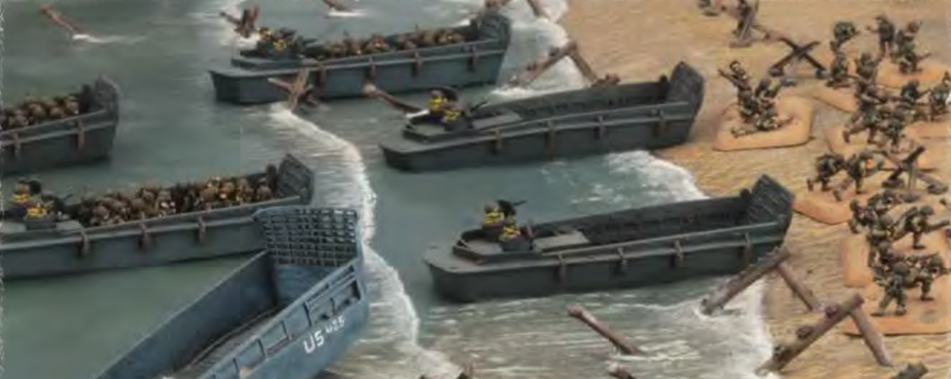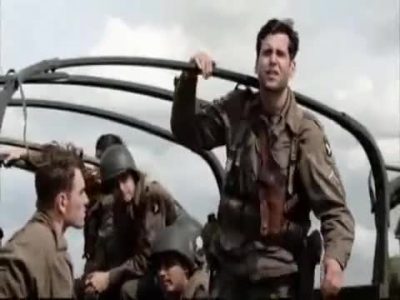Return of the 21st Panzer


By Benny Christiansen
With the new German D-Day book available, I made an effort to hurry and try to make a game with the two D-Day books. That means there will be some proxy units in the US list. Sorry for that and the poor quality of the photos. Blitz wasn’t working that day for the US or for the American player (me).
My friend is a veteran German player, so we decided to have a go at it. 80 points, as there will be a tournament later this year with 80 points D-Day books. My list was as follows:
 By Tom Gall
By Tom Gall
Battlefront’s German D-Day Command cards fall into line with what continues to be a newly established V4 tradition, release a book of new lists for a particular time and theatre of the war and at the same time, release a deck of command cards that complement the book with more force options and bits of flavor to add to your force.
I’ll cover a good number of the cards. My goal is to give you a feel for what is found in the card pack not review each and every card, though I do certainly cover the majority of them. If you have any questions, please reply to the article and I’ll happily answer.
There are 46 command cards for the German D-Day book. They span the range of named heroes (6), Tiger ace and accompanying cards, force or unit ability buffs, special modifications tied to a historical unit, new companies (2), and last swap outs (ex: Nebelwerfers in place of 10.5cm artillery).
By NDNG Dane
Battlefront announced the release of the new book. The new book allows the German players some exciting options to oppose the allies in Normandy.
In this article, we will look at some of the options available for the Beach Defense Companies. Returning to late-war in V4 is the 352nd and 716th Infantry Divisions. The base motivation for the Beach Defense Grenadier Company is Confident (4+), skill rating of Green (5+), and is rated as Aggressive (hit on a 3+).
The Beach Defense Companies start off looking like traditional Late War Grenadier Company. The basic building block of two (Beach Defense) Grenadier Platoons is the same, as are support options of an HMG34 platoon, 7.5CM Infantry Gun Platoon, 15CM Gun Platoon, 8CM Mortar Platoons, 12CM Mortar Platoon, 5CM Anti-Tank Platoon, and 7.5CM Anti-Tank Platoon.
Embarking on a Great Crusade D-Day Mega-Game
The Huntsville Historical Gamers gathered on 8 June to recreate the Allied Invasion of Europe. Operation Overlord was the codename for the Allied invasion of northwest Europe. The assault phase of Operation Overlord, was known as Operation Neptune. Operation Neptune began on D-Day (6 June 1944) and ended on 30 June 1944. By this time, the Allies had established a firm foothold in Normandy. Operation Overlord also began on D-Day, and continued until Allied forces crossed the River Seine on 19 August 1944.
One of the great sections contained towards the back of the new D-Day American book by Battlefront is the special missions that are thematic to D-Day. “Shot in the Dark“, “Help’s On Its Way” and “Fubar” model the airborne landings, the daring ranger assault on the coastal defenses and the landing themselves.
Battlefront has structured these such that they can be played individually or as a linked mini-campaign where the outcome of one game influences the next. It’s not quite a firestorm campaigns of yore, but certainly within the spirit of those past designs.

By Tom “Chairborne” Mullane

David Webster (101st Airborne)[at a passing column of German prisoners] “Hey, you! That’s right, you stupid Kraut *%&$! That’s right! Say hello to Ford, and General &@#$in’ Motors! You stupid fascist pigs! Look at you! You have horses! What were you thinking?”
For the longest time back in version 3, my least favorite matchup was to be put against an armored rifle company.
Not because the game wasn’t fun, it almost always was. But because, under V3 rules, I knew it would be an uphill road against a balanced, take all comers kind of force.
The Armored Rifle Company in Fighting First was always a competitive midwar choice in my opinion, but the strength of that list was in the support, not necessarily in the base platoons. It had Green Troops, and poor skill ratings, so many things became difficult. While shifting 14 stands will always present a problem, the Armored Rifles didn’t shine in midwar the way I knew they could. Those days are over here in Late War….
By Benny Christiansen
Hi, Ho Silver! Currahee! Rangers – lead the way!
One of the most (in)famous moments of the second world war seems to me to be D-Day. The landing on Omaha Beach was particularly hard but it was a huge undertaking and it must have been hard not to be awestruck at the sight of all the boats and airplanes.
With D-Day the Soviets finally had their second front opened. As I understand the history behind this, Stalin had been quite impatiently waiting for the Allies to put this operation into action to relieve some of the pressure on the Red Army.
In this article I’ll have a look at the Assault Company (also the veteran version) as well as Rifle Company (also the veteran version). I’ll try to make it like a tactical suggestion article, instead of the page-by-page version.
By Paolo Paglianti
The Battlefront plan is simple and bright.
Deploy the Fortress Europe book to start off the Late Period Flames of War V4, with all four principal armies in short form – good lists, but focused on the “general” armies after 1943 – and after that explore the various Late War theaters of war and their specific armies.
So, we’ve just finished drooling on Fortress Europe it’s already time to dive into a new, more specific book: ladies and gentlemen, time to get on our brand new Sherman 76mm and storm the D-Day beaches with your Late US army.